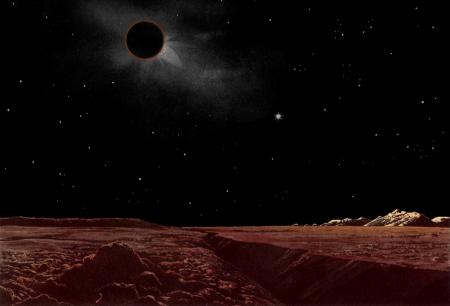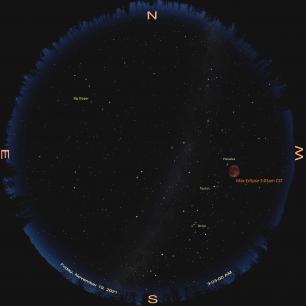Cosmic Curiosities
“If all fools could fly, the sun would be eclipsed forever.”
- Dutch Proverb
Coloring the Moon
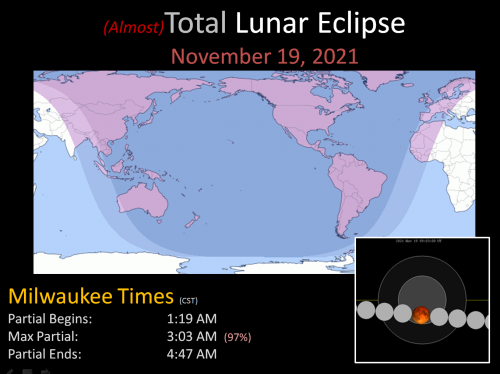 Total lunar eclipses are always a joy. We glimpse garish reds and oranges on the moon’s surface, but they all seem to shine in slightly diverse hues.
Total lunar eclipses are always a joy. We glimpse garish reds and oranges on the moon’s surface, but they all seem to shine in slightly diverse hues.
Why is the moon’s color different? The answers are many and varied. So, let’s start with the upcoming lunar eclipse on November 19—in the wee hours of the morning. Ouch!
The moon first moves into the Earth’s dark umbra shadow at 1:19 a.m. CST (a tough time for most of us). When the moon is half-darkened by our planet’s shadow cone around 2:00 a.m. CST, you will start to see a trace of red coloring. It’s not obvious because half the moon is still shining bright white! The contrast is so high it’s difficult to see subtle colors.
As the moon darkens, the crimson coloring grows! The maximum eclipse occurs at 3:03 a.m. CST, but not quite “total” with 97% of the moon in the umbral shadow. But it’s close, so we’re calling it an (almost) total lunar eclipse! At this max point, look for a very small sliver of white toward the moon’s southern edge.
For all lunar eclipses, the deeper the moon goes into our planet’s shadow, the darker the moon’s appearance. The amount of light always affects color. The upcoming eclipse will probably have a light orange color because it is not a deep eclipse.
One coloring factor is the condition of our atmosphere at the time of the eclipse. You may recall the recent fires out west in California caused suns and moons to appear a more reddish color. Besides dust and ash, the humidity and temperature of the air can also affect color. The height of the moon in the sky is a factor. Also, where you watch the eclipse can alter what you see—if you’re amongst the city lights or far out in the country.
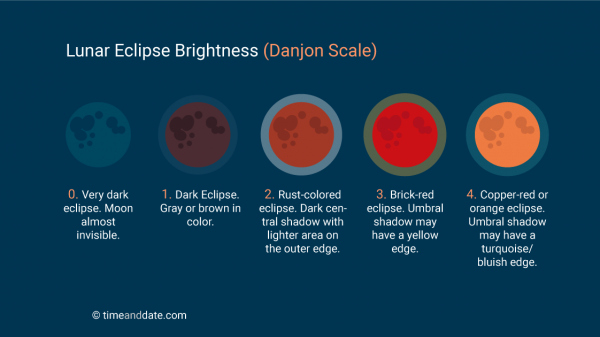
In 1921, French astronomer André-Louis Danjon created a five-point scale (Danjon Scale) to measure the appearance and luminosity of the moon during a total lunar eclipse. The rankings go from dark, called L0, to bright, or L4. See if you can chart November 19’s eclipse and where it falls on the Danjon Scale.
Why does the moon turn red in the first place? It’s the Earth’s atmosphere splitting and scattering the sun’s light into its spectral colors. Not all these wavelengths of light are spread out equally; the blue colors scatter more strongly at short distances and don’t reach the moon. The longer wavelengths, like red and orange, scatter, too—but over much longer distances which are able to reach the moon. If you were an astronaut standing on the moon on November 19, you would observe the Earth with a red ring around it.
While you are watching this middle of the night eclipse and admiring the moon’s color, don’t forget to notice the stars get brighter, especially if you are out in the country. The moon is like a gigantic bright street light blocking the stars. When eclipsed by the Earth’s shadow, the stars sparkle!
Why Fly?

Our Planetarium staff is creating a new program called DinoSOARS!, which tells the story of how birds came from dinosaurs million of years ago. It’s an amazing journey through time—stay tuned for details! As we started piecing the show together, we came across a rather simple question: Why fly? Why did birds take to the sky in the first place? I probably knew the answer to this, but I never really thought about it much.
The answer is that flight evolved for survival. It’s as simple as that. If a predator is chasing you down, the best way to escape is to fly! Researchers have found birds will give up flight if no predator is present. Of course, evolution has given our planet’s creatures all sorts of methods to evade capture. Animals have developed camouflage, acute senses, and heightened physical skills like speed. They also have developed defensive weapons to fight back and wear a predator down.
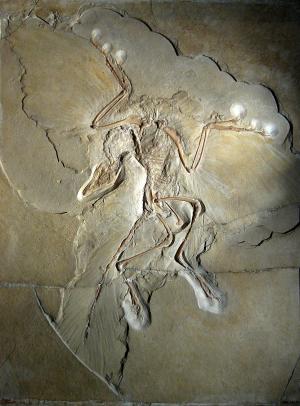 Paleontologists have shown evidence that feathers were first used to keep dinosaurs warm and for display. The use of feathered wings to fly came later. The first dinosaur discovered with feathers was Archaeopteryx, way back in 1861 in Germany. These dual features, feathers and dinosaur bones, were not accepted right away as a definitive link between the two. One roadblock preventing the idea that birds were descended from dinosaurs is that no one found a wishbone amongst the ancient fossils. One reason for this is that these bones just don’t last long after being underground for millions of years. But after further discoveries, we learned that even T. rex had a collarbone and maybe feathers!
Paleontologists have shown evidence that feathers were first used to keep dinosaurs warm and for display. The use of feathered wings to fly came later. The first dinosaur discovered with feathers was Archaeopteryx, way back in 1861 in Germany. These dual features, feathers and dinosaur bones, were not accepted right away as a definitive link between the two. One roadblock preventing the idea that birds were descended from dinosaurs is that no one found a wishbone amongst the ancient fossils. One reason for this is that these bones just don’t last long after being underground for millions of years. But after further discoveries, we learned that even T. rex had a collarbone and maybe feathers!
Human Flight
Way before the Wright brothers flew the first airplane, humans have dreamed of taking to the skies. Why? Was it simply our insatiable curiosity? Or maybe we wanted to find a pathway to the heavens?
There are stories throughout history in which humans mimicked birds. People would attach feathers to their arms and jump, trying to fly. Results were obviously not successful. About 500 years ago, Leonardo da Vinci studied flight more thoroughly. He made more than 100 drawings about the best ways to achieve flight.
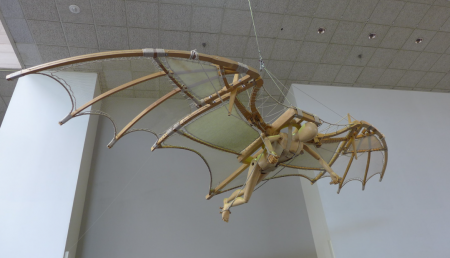
All along, humans were looking to birds to learn how to fly—and maybe with a little jealousy! The Wright brothers did, too. They noticed how birds soar into the wind. Observations told them how lift is created when air flows over a bird’s curved wing surface—and how birds change the shape of their wings to turn the flight direction. All this study helped them achieve flight in 1903.
Our rockets today are exposed to the same forces of flight. Engineers must account for four forces of flight: weight, thrust, lift, and drag. The relative scale and path of these forces determine if the rocket will go where it’s supposed to.
It’s strange to think that our ability to fly—to reach the moon, to send spacecrafts throughout the solar system—might give us humans a better chance to survive. That is, if we ever have the need to find another place to live.
Dolphins in the Sky
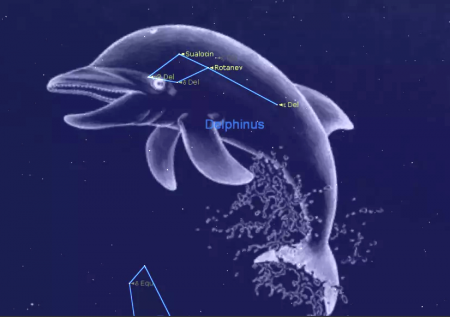 It’s always fascinating how much we see of both ourselves and the Earth when we look to the stars.
It’s always fascinating how much we see of both ourselves and the Earth when we look to the stars.
One of my long-time favorite constellations is Delphinus—meaning “dolphin” in Latin. The Greek story says Poseidon sent the dolphin to locate a sea nymph he wanted to marry. Another tale reveals a Greek poet named Arion whose life is saved by dolphins.
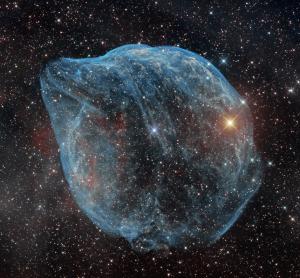 Another space-dolphin I like is the Dolphin Head nebula, located in Canis Major, the big dog, below the night sky’s brightest star, Sirius. Nebulae names reflect what we think they look like—so I like to call them “nebula constellations.” This nebula is a result of intense heat from a massive blue star located in the middle of the nebula. These furious photons race outward and slam into the surrounding oxygen gas, causing it to glow a beautiful blue. The star is more than 20 times the mass of the sun and believed to one day go supernova. This billowing space cloud is huge at more than 60 light years wide! Our solar system out to Pluto is only 0.0007 light years wide.
Another space-dolphin I like is the Dolphin Head nebula, located in Canis Major, the big dog, below the night sky’s brightest star, Sirius. Nebulae names reflect what we think they look like—so I like to call them “nebula constellations.” This nebula is a result of intense heat from a massive blue star located in the middle of the nebula. These furious photons race outward and slam into the surrounding oxygen gas, causing it to glow a beautiful blue. The star is more than 20 times the mass of the sun and believed to one day go supernova. This billowing space cloud is huge at more than 60 light years wide! Our solar system out to Pluto is only 0.0007 light years wide.
Sky Sights
Click maps to enlarge.
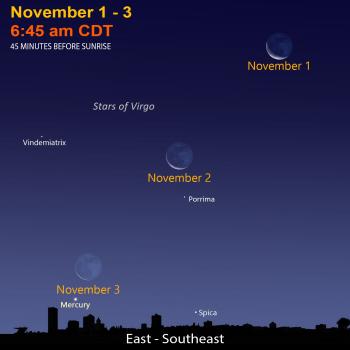 You can catch elusive Mercury in the morning sky, but only in early November. Your best bet will be November 1-3, when a waning crescent Moon wanders by the smallest planet and the stars of Virgo.
You can catch elusive Mercury in the morning sky, but only in early November. Your best bet will be November 1-3, when a waning crescent Moon wanders by the smallest planet and the stars of Virgo.
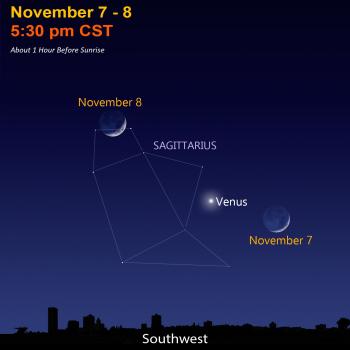 Venus is still visible low in the southwest sky in the constellation Sagittarius the Archer. A young crescent Moon joins the hot planet on November 7-8.
Venus is still visible low in the southwest sky in the constellation Sagittarius the Archer. A young crescent Moon joins the hot planet on November 7-8.
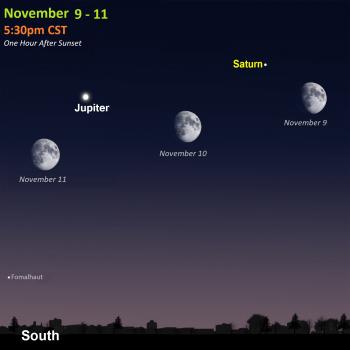 Jupiter and Saturn move a little more to the southwest after sunset. Look for the Moon to orbit in front of the two distant planets from November 9-11.
Jupiter and Saturn move a little more to the southwest after sunset. Look for the Moon to orbit in front of the two distant planets from November 9-11.
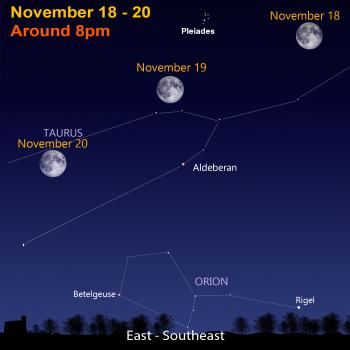 By mid-November, our old winter friend, Orion the Hunter, returns to the evening sky. This bright constellation clears the eastern horizon about 8:00 p.m. CST. By the end of the year, Orion’s stars will be shining in the same direction as soon as it grows dark—around 5:00 p.m. in Wisconsin.
By mid-November, our old winter friend, Orion the Hunter, returns to the evening sky. This bright constellation clears the eastern horizon about 8:00 p.m. CST. By the end of the year, Orion’s stars will be shining in the same direction as soon as it grows dark—around 5:00 p.m. in Wisconsin.
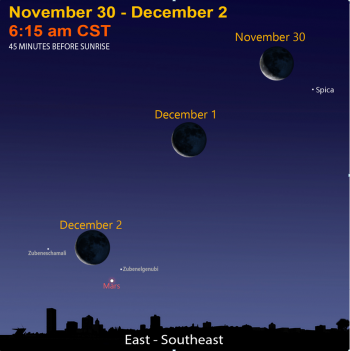 Another waning crescent Moon can be seen again at month’s end. This time, it shines close to Mars from November 30 to December 2, about 45 minutes before sunrise.
Another waning crescent Moon can be seen again at month’s end. This time, it shines close to Mars from November 30 to December 2, about 45 minutes before sunrise.
November Star Map
Sign Up
Receive this newsletter via email!
Subscribe
See the Universe through a telescope
Join one of the Milwaukee-area astronomy clubs and spot craters on the Moon, the rings of Saturn, the moons of Jupiter, and much more.
Follow Bob on social media
Twitter: @MPMPlanetarium
Facebook: Daniel M. Soref Planetarium


